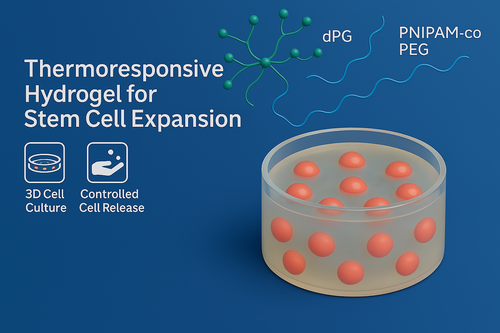Thermoresponsive hydrogels as microniches for the growth and controlled release of pluripotent stem cells and preparation method thereof
A novel thermoresponsive hydrogel, combining dendritic polyglycerol units with poly(N-isopropylacrylamide)-co-polyethylene glycol via a bioorthogonal linker, creates a dynamic microniche for robust iPSC expansion and controlled cell release. Its thermoreversible properties enable gentle, efficient harvesting by simple temperature adjustment.
Innovation Explanation
This invention describes a fully defined, synthetic 3D cell culture system based on a thermoresponsive hydrogel that mimics the natural extracellular matrix. The hydrogel is formed by covalent bonding of dendritic polyglycerol (dPG) units to poly(NIPAAm-co-PEG) units via an in situ click reaction (using a cyclic triazol or diazacyclohexadiene linker). At temperatures below its lower critical solution temperature (LCST, approximately 29–35 °C), the gel exists as a chemically crosslinked network; when warmed (e.g., to 37 °C), physical gelation occurs to create a stable, ECM-like environment supporting the robust expansion of induced pluripotent stem cells (iPSCs). Upon lowering the temperature below the LCST, physical gelation reverses, enabling controlled, mild release of the expanded cells while retaining high viability and pluripotency.
Key Innovation Features and Advantages
- Dual Gelation Mechanism: Combines permanent covalent crosslinking with reversible physical gelation to ensure stability during culture and ease of cell harvest.
- Thermoresponsive Behavior: Above the LCST the gel provides optimal mechanical support; below it, the softening enables gentle cell release.
- Biochemical Enhancement:Optional incorporation of cyclic RGD peptides promotes superior cell attachment and growth within the niche.
- Tunable Elasticity: Customizable elastic modulus (ranging from 15 to 1500 Pa) tailors the 3D microenvironment for optimal iPSC expansion.
Use Cases
- 3D Stem Cell Cultivation: Provides an artificial, ECM-mimicking niche that supports rapid and high-quality expansion of iPSCs.
- Controlled Cell Harvesting: Enables non-invasive, temperature-triggered release of cells, facilitating efficient downstream processing.
- Tissue Engineering Applications: Can be adapted as a scaffold for regenerative medicine, where controlled cell growth and release are critical.
Commercial Opportunities
- Scalable Regenerative Medicine Platform: Addresses the growing demand for patient-specific iPSC cultures in cellular therapies and tissue engineering.
- Cost-Effective and Defined System: Fully synthetic formulation reduces batch variability and contamination risks common with animal-derived matrices.
- Versatile Biomedical Application: The system’s tunable properties and simple thermal control make it attractive for drug screening, cell therapy products, and research tools.
Current Status
The thermoresponsive hydrogel system is in the preclinical stage with extensive in vitro evaluations. Optimization of precursor ratios, stiffness parameters, and seeding densities has confirmed its ability to support rapid iPSC proliferation, maintain pluripotency, and enable controlled, gentle cell release. The reproducible, fully defined synthesis process stands poised for scale-up and further regulatory development.

Keywords
- Thermoresponsive Hydrogel, Dendritic Polyglycerol, pNIPAAm-co-PEG, 3D Cell Culture, Induced Pluripotent Stem Cells, Controlled Release, Artificial Microniche, Regenerative Medicine.
